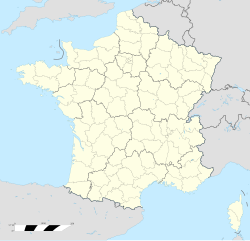納博訥戰役
此條目沒有列出任何參考或來源。 (2015年2月12日) |
納博訥戰役發生於西元737年,由代表安達盧斯的塞普提曼尼亞奧瑪亞哈里發國總督尤素福·阿爾-菲赫里率領的阿拉伯與柏柏爾穆斯林軍隊,對抗由加洛林公爵查理·馬特領導的法蘭克王國基督教軍隊[1][2][3][4]。
背景
[編輯]塞普提曼尼亞位於高盧南部,是西哥德王國尚未被征服的最後一個省份[6] 。倭馬亞王朝入侵此地,目的是鞏固他們在伊比利亞半島的領土成果[6] 。719年,倭馬亞軍隊開始進軍塞普提馬尼亞[6]。
該地區於719年由安達盧斯瓦利——薩姆·伊本·馬利克·考拉尼率軍入侵[6],並於720年被阿拉伯和柏柏爾軍隊佔領[1][3]。納博訥(Narbonne)改名為阿爾布納(Arbūnah),並成為未來軍事行動的基地[7]。
到721年,薩姆得到增援,準備攻打土魯斯,希望如同征服塞普提馬尼亞一般攻下亞奎丹。然而,他在721年的土魯斯戰役中遭遇慘敗,由亞奎丹公爵偉大的奧托領軍的基督徒軍隊擊潰了穆斯林,取得關鍵勝利[5]。在此戰役中,薩姆受重傷,最終在納博訥身亡[5]。
在720年代,穆斯林軍穩固控制納博訥,並從海上獲得補給。他們於725年攻下塞普提馬尼亞西北邊緣的卡爾卡松,並突襲其他城市。731年,塞爾達尼亞地區的柏柏爾領主穆努扎與奧托聯盟,叛變對抗哥多華埃米爾國,但最終被白衣大食指揮官阿卜杜勒殺死。737年,查理·馬特在攻下攻下亞維農後,率軍圍攻納博訥[2],但無法攻克該城[4]。之後,法蘭克軍轉向尼姆、阿格德與貝濟耶進攻[2][4]。
戰鬥
[編輯]737年,加洛林公爵查理·馬特再次進攻納博訥[2][4] ,但當地的哥特人和高盧-羅馬貴族結成軍事與政治聯盟[8],對抗法蘭克勢力擴張。儘管查理試圖征服整個塞普提馬尼亞,但其軍隊無法攻克納博訥[2]。當阿拉伯軍隊從伊比利亞半島派遣援軍時,法蘭克軍在現今奧德省的貝爾河口成功攔截,並取得重大勝利[2][5] 。隨後,法蘭克軍隊轉向攻擊尼姆[2][4]。
撤退
[編輯]如果法蘭克宮廷長查理·馬特願意投入軍隊和全部資源進行無限期圍攻,他或許能夠攻占納博訥,但他不願意或無法這樣做[2]。他很可能發現阿基坦公爵霍納德一世正在威脅他與北方的交通線。此外,普羅旺斯的貴族莫龍德從他未被征服的城市馬賽,從後方發動了反抗他的叛亂[9] 。與此同時,法蘭克國王還可能認為,透過摧毀塞普蒂曼尼亞的阿拉伯穆斯林軍隊,並將剩餘的阿拉伯和柏柏爾駐軍限制在納博訥城內,他的主要目標已經實現;於是不再選擇繼續進攻[1]。
739年下半,查理再次發動軍事行動,驅逐不再受安達盧斯支援的莫龍德,奪回馬賽與普羅旺斯控制權。根據保羅執事所著的《倫巴底人史》,當穆斯林得知查理與倫巴底人結盟後,便從該地撤軍,致使穆斯林軍隊與莫龍德勢單力薄,不敢應戰。
參考資料
[編輯]- ^ 1.0 1.1 1.2 1.3 1.4 1.5 Deanesly, Margaret. The Later Merovingians. A History of Early Medieval Europe: From 476–911. Routledge Library Editions: The Medieval World 1st. London and New York City: Routledge. 2019: 244–245. ISBN 9780367184582.
- ^ 2.00 2.01 2.02 2.03 2.04 2.05 2.06 2.07 2.08 2.09 2.10 Verbruggen, J. F. The Role of the Cavalry in Medieval Warfare. Rogers, Clifford J.; Bachrach, Bernard S. (編). The Journal of Medieval Military History: Volume III. Woodbridge, Suffolk: Boydell Press. 2005: 55–56. ISBN 9781846154058. doi:10.7722/j.ctt81qwd.6.
After 734 Charles Martel advanced against the nobles in Burgundy and placed the region of Marseilles under the authority of his counts. [...] Charles marched afterwards to Narbonne and sieged it. Then an army of Saracens came to relieve Narbonne. Charles marched against them and defeated them along the banks of the Berre. Charles still devastated the area around Nîmes, Agde, and Béziers, but an uprising in Saxony caused him to make an expedition to hold onto that land. [...] Charles Martel had subjected the whole of Gallia, again by battles, and had to siege Avignon and Narbonne there. He did not have the time to conquer Septimania.
- ^ 3.0 3.1 3.2 3.3 Collins, Roger. Italy and Spain, 773–801. Charlemagne. Buffalo, London and Toronto: Palgrave Macmillan/University of Toronto Press. 1998: 65–66. ISBN 978-1-349-26924-2. doi:10.1007/978-1-349-26924-2_4.
- ^ 4.0 4.1 4.2 4.3 4.4 4.5 4.6 4.7 Collins, Roger. Conquerors Divided. The Arab Conquest of Spain: 710–797. Chichester, West Sussex: Wiley-Blackwell. 1995: 92. ISBN 978-0-631-19405-7.
It would be quite anachronistic that the Provençal aristocracy would or those whose primary interests lay in the south would welcome the extension into their region of the authority of the eastern Frankish Mayors of the Palace, or that a sense of Christian solidarity should mean more than the dictates of realpolitik. For that matter it was not with any sense of obligation to free formerly Christian lands from Islamic rule that Charles Martel launched a raid into western Provence in 737. He took Avignon, but clearly did not retain it, and advanced to siege Narbonne, the centre of Arab control in the March. The Frankish chronicles record his victory over a relieving force sent by the governor ʿUqba, but their uniform silence makes it clear that despite this he failed to take the city itself.
- ^ 5.0 5.1 5.2 5.3 Baker, Patrick S. The Battle of the River Berre. Medieval Warfare (Karwansaray BV). 2013, 3 (2): 44–48. ISSN 2211-5129. JSTOR 48578218.
After three months, Eudo the Great, Duke of Aquitaine, lifted the siege. Eudo's army decimated the Moors, killed As-Sahm and drove the survivors from Aquitaine.
- ^ 6.0 6.1 6.2 6.3 Christys, Ann (2002). Christians in Al-Andalus (711-1000). London: Routledge, ISBN 0-7007-1564-9, p. 28.
- ^ Holt, P. M., Lambton, Ann K. S. and Lewis, Bernard (1977). The Cambridge History of Islam. Cambridge: Cambridge University Press. ISBN 0-521-29135-6, p. 95.
- ^ Meadows, Ian. The Arabs in Occitania. Saudi Aramco World. March–April 1993, 44: 24–29.
- ^ Lewis, Archibald R. The Development of Southern French and Catalan Society, 718–1050. Austin: University of Texas Press. 1965: 23 [June 15, 2012].


